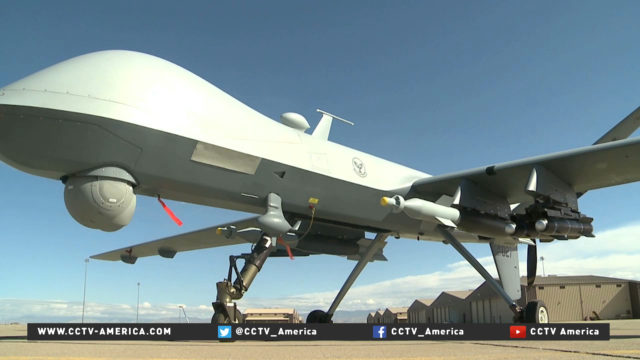Captain James showcases one of the U.S. military’s top weapons in its fight against terror.
But in many ways this is not like most other aircraft. The MQ-9 Reaper is the U.S. Air Force’s most advanced drone or “remotely piloted aircraft” in use today.
CCTV America’s Karina Huber reports.

A sensor in the front acts as its eyes and unlike a conventional aircraft no one sits in it.
Pilots of the MQ-9 sit in so-called “ground control stations” that resemble cockpits often housed inside trailers on Air Force bases throughout the Southwestern United States.
From those trailers they control the aircraft remotely as they engage in air strikes and surveillance operations thousands of kilometers away in places like Iraq and Afghanistan.
The Holloman Air Force Base in the Chihuahua desert in New Mexico is a sort of boot camp for remotely piloted aircraft or RPA pilots. Roughly 390 new pilots will be trained this year to operate RPA’s like the one you see behind me. Now the number may sound like a lot but it’s actually not enough. With the U.S. military increasingly relying on RPA’s for surveillance and for military strikes, the air force now faces a pilot shortage.
Captain James, whose last name must remain secret for security reasons, is training many of the new recruits. He said “The biggest challenge in being an RPA pilot is maintaining situational awareness without the tools of a traditionally manned aircraft. So for instance there’s no cockpit to look out of. So our big challenge here is teaching the students to use the tools available to us in the ground control station to build and maintain that situational awareness.”
The Air Force has faced an RPA pilot shortage since at least 2007. It’s reportedly had some difficulty in recruiting and retaining them.
According to Lieutenant Colonel Steven Beattie, part of the problem is fatigue.
“The manpower that we’ve had has been such that our crews are working six days a week, two days off and continuing on a rotating shift like that…through holidays, weekends and everything and they do that for three to four years at a time without a break and that just kind of wears on you after a while,” Lt. Col. Steven Beattie, Training Squadron Commander said.
It can also take an emotional toll. Just because they are thousands of kilometers away from the action doesn’t mean they are disconnected from the mission.
A Defense Department study shows that RPA pilots suffer from the same levels of post-traumatic stress syndrome as traditional fighter pilots.
To deal with the shortage, the Air Force has launched a multi-pronged strategy. It is offering bonuses of $15,000 a year and lowering the number of missions from 65 to 60 per day to ease the workload. Some flight school graduates will also automatically be assigned to RPAs.
And the Air Force is working hard to alter the image of RPA pilots. The U.S. Air Force expects to overcome its shortage by 2017.
Professor Christine Fair on how the US military is trying to make up for the drone pilot shortage
CCTV America’s Mike Walter spoke to Christine Fair. She’s an associate professor with the Security Studies Program at Georgetown University and has worked for the United Nations in Kabul.

 CGTN America
CGTN America

